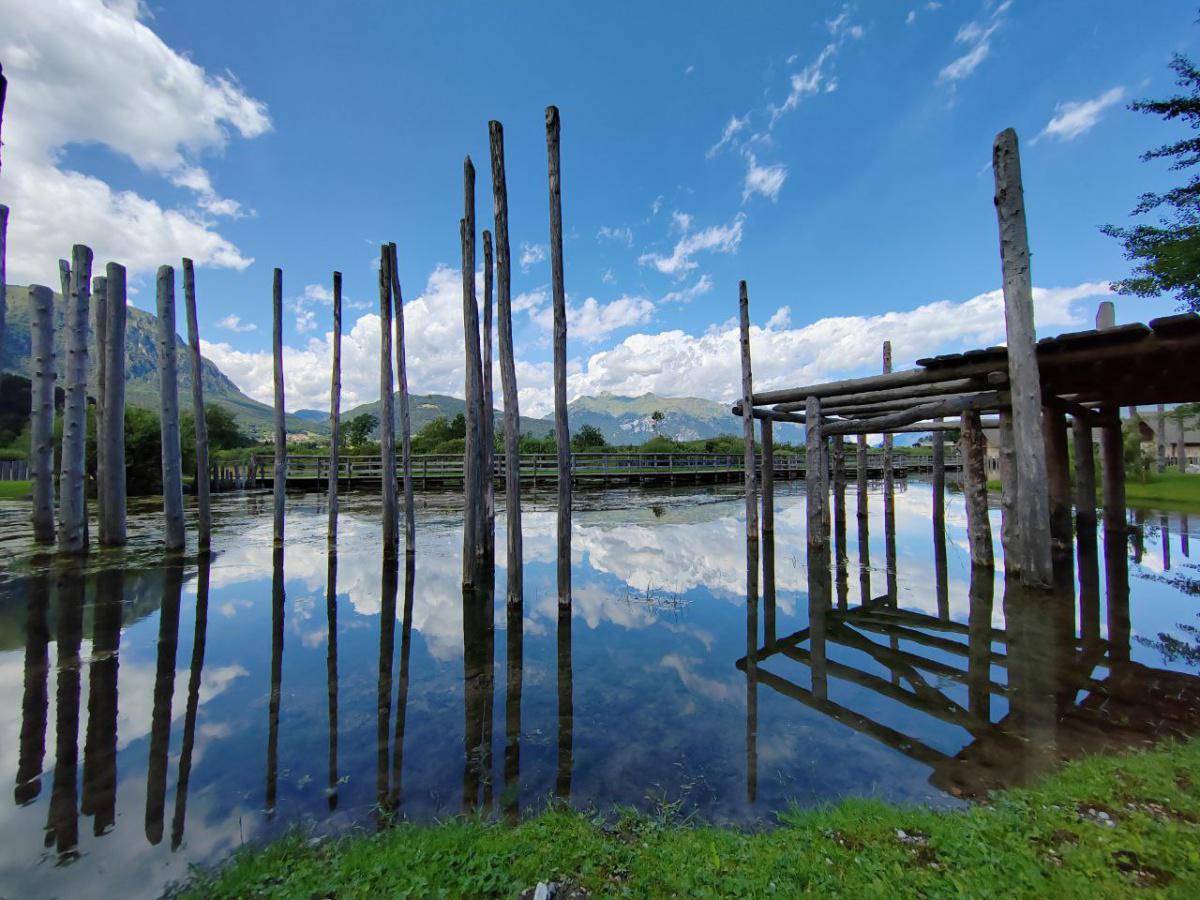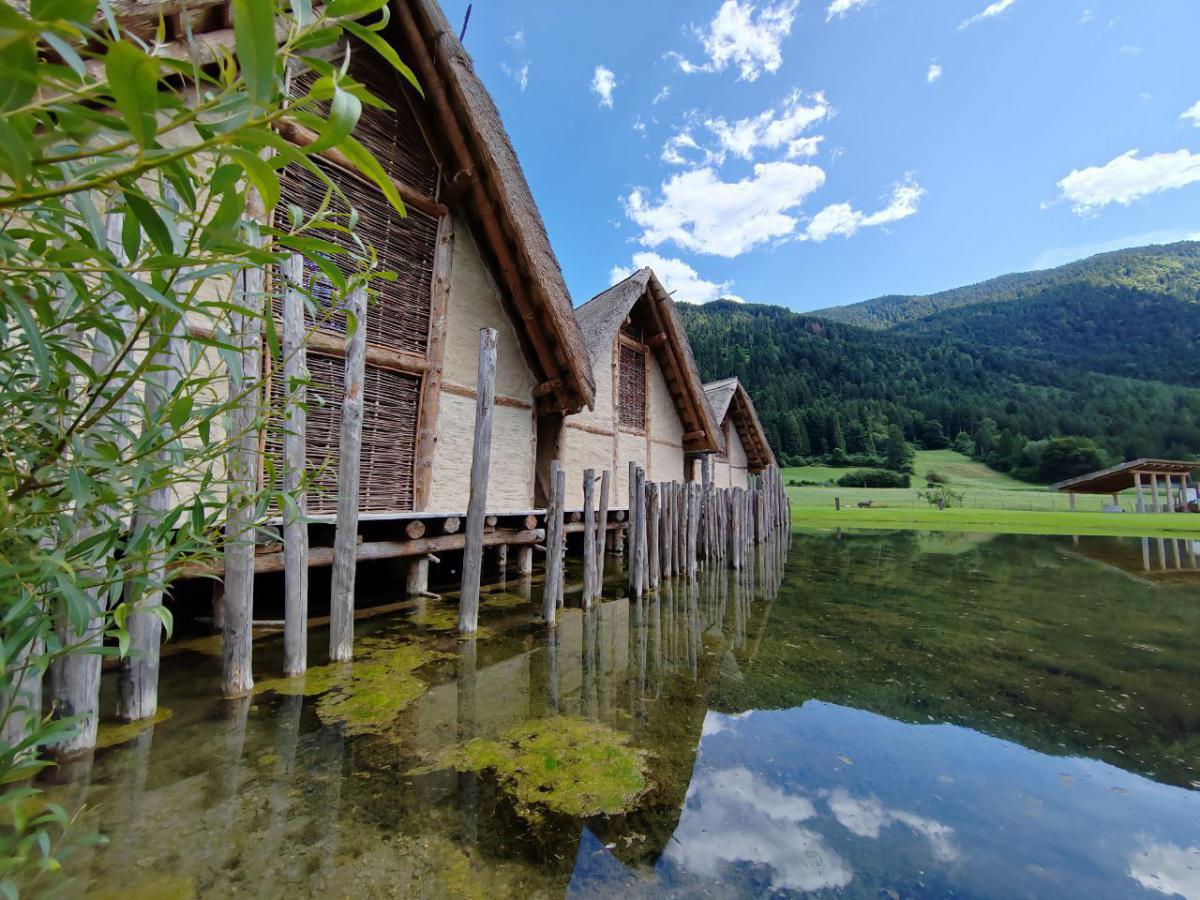Palafitte di Fiavè - Parco Archeo Natura
Fiavè Fiavè TN
Le palafitte di Fiavé, assieme alle palafitte di Ledro e ad altri 109 aree archeologiche, fanno parte del sito seriale e transnazionale "Siti palafitticoli preistorici dell’arco alpino” dal 2011 incluso nella Lista del Patrimonio Mondiale dell’UNESCO.
La scoperta dell'esistenza di un abitato preistorico nel bacino dell'ex lago Carera, progressivamente intorbatosi, avvenne nella metà dell'800 in seguito a lavori di estrazione della torba.
Dal 1969 al 1976 furono intraprese ricerche sistematiche, che interessarono due zone distinte della torbiera e l'attiguo Dos Gustinaci, riprese nel 1981 con indagini alle quali hanno preso parte Istituti, Musei ed Università italiane ed estere.
Gli esiti delle ricerche sono documentati nel vicino Museo delle Palafitte di Fiavé dove sono esposti gli straordinari reperti rinvenuti nel corso degli scavi e dove è visibile un grande plastico con la minuziosa ricostruzione del villaggio "Fiavé 6".
Nell'area archeologica delle Palafitte di Fiavé sono visibili i resti dei pali delle costruzioni preistoriche. Il sito si trova all'interno della riserva naturale Carera ed è visitabile liberamente.
A pochi passi dall'area archeologica si trova il Parco Archeo Natura : la visita è un affascinante viaggio nel tempo nell’atmosfera del villaggio palafitticolo dell'età del Bronzo lungo un percorso coinvolgente con capanne ricostruite in scala reale, installazioni, pannelli informativi, un centro visitatori con filmati e apparati multimediali, spazi dedicati alle famiglie e ai più piccoli.
Dal Museo delle Palafitte di Fiavé all'area archeologica
Il sito è raggiungibile a piedi dall'abitato di Fiavé, in circa 30 minuti, lungo un comodo percorso che parte da via 3 Novembre a poche centinaia di metri dal museo, oppure in automobile lungo la strada provinciale n.421 seguendo le indicazioni per Passo del Ballino - Riva del Garda con parcheggio presso il Dos Gustinaci.
APERTURE
Dal 30 marzo al 17 giugno: sabato, domenica, lunedì e festivi ore 13-18
Dal 22 giugno al 31 agosto: tutti i giorni ore 10-19
Dal 1° al 30 settembre: tutti i giorni ore 10-18
Dal 1° al 13 ottobre: tutti i giorni ore 10-17
Fonte: https://www.cultura.trentino.it/
EN
The pile dwellings of Fiavé, together with the pile dwellings of Ledro and 109 other archaeological sites, are part of the serial and transnational site "Prehistoric pile-dwelling sites in the Alps" included in the UNESCO World Heritage List since 2011.
The discovery of the existence of a prehistoric settlement in the basin of the progressively silted-up former Lake Carera occurred in the mid-19th century as a result of peat extraction work.
From 1969 to 1976, systematic research was undertaken, involving two distinct areas of the peat bog and the adjacent Dos Gustinaci, which was resumed in 1981 with investigations in which Italian and foreign institutes, museums and universities took part.
The results of the research are documented in the nearby Palafitte di Fiavé Museum where the extraordinary finds unearthed during the excavations are on display and where a large model with a detailed reconstruction of the 'Fiavé 6' village can be seen.
In the archaeological area of the Fiavé pile dwellings, the remains of the piles of prehistoric constructions are visible. The site is located within the Carera nature reserve and can be visited freely.
A few steps away from the archaeological area is the Parco Archeo Natura: the visit is a fascinating journey through time in the atmosphere of the Bronze Age pile-dwelling village along an enthralling route with full-scale reconstructed huts, installations, information panels, a visitors' centre with films and multimedia equipment, and spaces dedicated to families and children.
From the Fiavé Pile-Dwelling Museum to the archaeological area
The site can be reached on foot from the town of Fiavé, in about 30 minutes, along an easy route that starts from Via 3 Novembre a few hundred metres from the museum, or by car along provincial road no. 421 following the signs for Passo del Ballino - Riva del Garda with parking at Dos Gustinaci.
OPENINGS
30 March to 17 June: Saturdays, Sundays, Mondays and public holidays 1-6 pm
22 June to 31 August: daily 10am-7pm
1 to 30 September: daily 10am-6pm
1 to 13 October: daily 10-17 hrs.
DE
Die Pfahlbauten von Fiavé sind zusammen mit den Pfahlbauten von Ledro und 109 weiteren archäologischen Stätten Teil der seriellen und transnationalen Stätte "Prähistorische Pfahlbauten in den Alpen", die seit 2011 auf der Liste des UNESCO-Welterbes steht.
Die Entdeckung einer prähistorischen Siedlung im Becken des zunehmend verlandenden ehemaligen Carera-Sees erfolgte Mitte des 19. Jahrhunderts im Zuge von Torfabbauarbeiten.
Von 1969 bis 1976 wurden systematische Forschungen in zwei verschiedenen Bereichen des Torfmoores und des angrenzenden Dos Gustinaci durchgeführt, die 1981 mit Untersuchungen fortgesetzt wurden, an denen italienische und ausländische Institute, Museen und Universitäten beteiligt waren.
Die Forschungsergebnisse sind im nahe gelegenen Museum von Palafitte di Fiavé dokumentiert, wo die außergewöhnlichen Funde der Ausgrabungen ausgestellt sind und ein großes Modell mit einer detaillierten Rekonstruktion des Dorfes "Fiavé 6" zu sehen ist.
In der archäologischen Zone der Pfahlbauten von Fiavé sind die Überreste der Pfähle der prähistorischen Bauten zu sehen. Die Stätte befindet sich im Naturschutzgebiet Carera und kann frei besichtigt werden.
Nur wenige Schritte von der archäologischen Zone entfernt befindet sich der Parco Archeo Natura: Der Besuch ist eine faszinierende Zeitreise in die Atmosphäre des Pfahlbaudorfes aus der Bronzezeit entlang eines spannenden Weges mit originalgetreu rekonstruierten Hütten, Installationen, Informationstafeln, einem Besucherzentrum mit Filmen und multimedialer Ausstattung sowie Räumen für Familien und Kinder.
Vom Pfahlbaumuseum Fiavé zum archäologischen Gebiet
Von Fiavé aus erreicht man die Ausgrabungsstätte in etwa 30 Minuten zu Fuß über einen einfachen Weg, der wenige hundert Meter vom Museum entfernt in der Via 3 Novembre beginnt, oder mit dem Auto über die Provinzstraße 421, die in Richtung Passo del Ballino - Riva del Garda ausgeschildert ist, mit Parkplatz in Dos Gustinaci.



